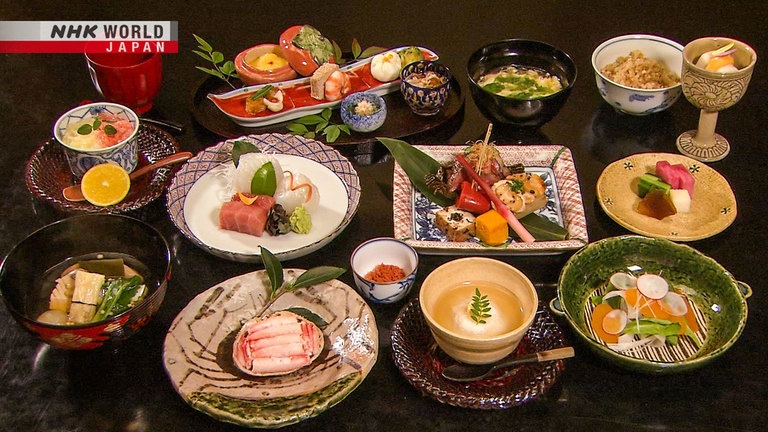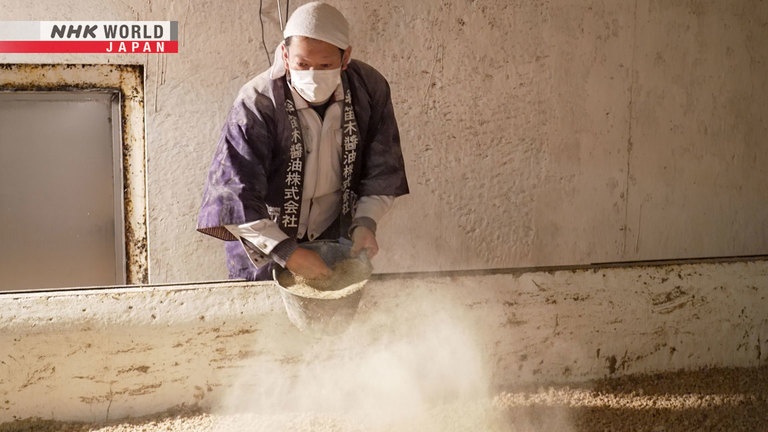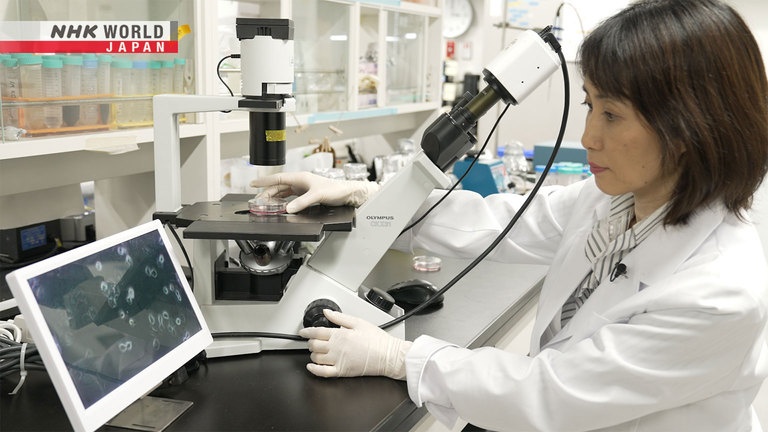The Wonders of Washoku - Exploring the Infinite Possibilities of Microbes
Do you love soy sauce or sake? Discover how a single type of microbe, Aspergillus Oryzae, enhances the flavor of Washoku, captivating fans worldwide.




Transcript
Sushi.
Sukiyaki.
And sake.
Traditional Japanese cuisine, or "Washoku," is now capturing the hearts of people around the world.
After the first bite, you keep coming back for more.
But did you know...
this infinite world of flavors you find in rice, soybeans and wheat
is brought out by sprinkling one particular type of microorganism.
Almost like a world of magic.
The Japanese had discovered the presence of this invisible form of life more than a thousand years ago
and over the years, they have brought it to its fullest potential.
Today, we will scientifically examine this teeny tiny organism that support Japan's food culture.
At the National Museum of Nature and Science, they are holding a unique event.
The "Washoku" Exhibition.
To mark the 10-year anniversary of "Washoku" being registered as a UNESCO Intangible Cultural Heritage,
they are introducing the background of traditional Japanese food.
Dr. Hosoya Tsuyoshi, who supervised the special exhibit, conducts research on the culture of traditional Japanese cuisine.
What aspects of "Washoku" were evaluated for it to be listed as a UNESCO Intangible Cultural Heritage?
"Washoku" is rooted in the spirit
of respecting Japan's nature.
The techniques and wisdom involved
in the acquisition of ingredients,
production, preparation and consumption
were recognized.
"Washoku" has developed over a long period of time,
centering around the delicacies from the sea and mountains nurtured by Japan's unique climate and terrain.
Among the many exhibits, there is one particularly important display that is essential to "Washoku."
It may not appear to be a kind of ingredient.
It's an extremely small type of mold.
This is a model that's magnified
by 1,000 times.
The yellow koji mold, Aspergillus oryzae,
is the most fundamental element of "Washoku."
Aspergillus oryzae.
It is a microfungus merely a few microns in size.
Oryzae means rice in Latin and Aspergillus oryzae thrives while fermenting grains such as rice and soybeans.
When it attaches to rice, it helps to make sweet cooking wine or sake.
And adding it to soybeans produces soy sauce and miso.
This brought about Japan's unique array of seasonings, inspiring the creation of countless dishes with endless variations.
For over 1,000 years, this invisible microbe has played an important role in Japan's culture.
This is an illustration from the Edo period.
It depicts the process of producing the mold.
In Japan, the business of koji production, known as "tanekojiya" has existed for roughly 800 years,
making it one of the world's oldest biotech businesses.
Aspergillus oryzae is a type of mold, but molds are generally harmful to our health, so is it safe?
A. oryzae is closely related to Aspergillus Flavus,
known for producing strong toxin.
Some of its genes
are partially present in A. oryzae,
but a crucial part of the gene is damaged
so it's proven to not produce toxins.
A study published in 2005 found that genes associated with toxins originally found in Aspergillus oryzae are damaged.
The mold used in "Washoku" is safe and has been improved over the years by the Japanese.
Thus, Aspergillus oryzae is a mold that cannot be found in nature.
A. oryzae plays an essential role in "Washoku."
It's crucial in producing the seasonings for "Washoku,"
like miso and soy sauce and also for sake.
This mold creates all the umami taste
that characterizes Japanese cuisine.
Aspergillus oryzae produces the rich umami flavor.
Now, let's take a look at some of its amazing abilities.
This is Kenji Maehashi of Tokyo University of Agriculture.
He investigates the influence Aspergillus oryzae has on the taste of "Washoku."
What do you have in your hands?
This is A. oryzae growing on soybeans and wheat.
It produced spores that have turned yellow.
When the mold is sprinkled on steamed soybeans and kept at the right temperature and humidity...
a thick layer grows.
When it proliferates on rice or soybeans, this state is referred to as "koji," a familiar name to the Japanese.
The secret to the delicious taste of Japanese food lies in the activities of Aspergillus oryzae.
Let's take a close look.
A. oryzae is growing on the surface of the koji.
The white threads are mycelia
which have spores at the tips.
They break down the components of soybeans,
absorb the nutrients and continue to grow.
To do so, the mold produces enzymes.
An enzyme is a substance that helps break
down starch into glucose and proteins into amino acids.
By nature, proteins and starches in grains lack flavors such as umami and sweetness.
Here, the mold was doing something remarkable.
During its growth, Aspergillus oryzae produces large amounts of enzymes to obtain nutrients.
Enzymes have the ability to break down various substances.
Breaking down proteins yields amino acids like glutamic acid,
which serve as the source for umami, bitterness, sourness and other tastes.
Breaking down starches yields sugar, which contributes to sweetness.
Deep and complex flavors are created by the activities of this mold.
Now, let's take a look at how amino acids are made from proteins.
A protein sample is placed in a petri dish.
Next, a few drops of enzymes produced by the Aspergillus oryzae are added.
24 hours later...
The area around the enzyme has become transparent.
This is proof that the proteins has been broken down into amino acids.
Proteins turn into 20 different types of amino acids
and all 20 types have been produced.
This brings about the complex flavor.
There's not just 1, but 20 different types,
each with its own unique taste.
When combined, they create a rich flavor.
Richness implies a profound taste,
adding depth and complexity to the flavor.
Many foods around the world utilize fermentation during its production.
Cheese,
fish sauce,
yogurt.
However, unlike Aspergillus oryzae, most of the microbes involved in the fermentation are natural, rather than human-made.
And it's hard to find microbes that can match it in creating umami.
Recent genetic studies have shown that there are over 100 genes involved in the production of umami.
Throughout its long history, the Japanese have refined the mold to produce more umami.
Fungi typically have enzymes that break down proteins,
but A. oryzae is particularly outstanding.
That is why it was used for koji and our ancestors figured out
that this mold could craft the best flavor.
We now know the reason is because
it's especially good at making enzymes.
Furthermore, Aspergillus oryzae has an outstanding ability to break down starch and produce sugar.
Using these two strong abilities, it creates the deep flavors in Japanese cuisine that capture the hearts of many people.
Aspergillus oryzae has been a part of Japanese cuisine for roughly 1,000 years.
Craftsmen have refined their skills and maximized the potential of the mold through carefully handling the living organism.
This is a soy sauce manufacturer that has been around for 235 years.
Fueki Kichigoro is the 12th generation president of the company.
Every morning, he expresses gratitude to his ancestors who have preserved the soy sauce brewery to ensure that this tradition lives on.
On this day, the workers will begin preparing soy sauce, which will take over a year to complete.
For the next 3 days, we will
let the koji rest in a special room.
I'm a bit nervous, since it's the first koji-making
of the year and anything can happen.
We're dealing with living organisms,
so I feel the pressure every time.
Although the facility has been upgraded dramatically,
the process of soy sauce making has remained the same as it was at the beginning.
First, soybeans are steamed.
Meanwhile, Aspergillus oryzae is mixed with cracked wheat.
Next, all the ingredients are mixed together to make koji.
The koji is then mixed with salt water and left to ferment and mature for 1 to 2 years.
Finally, soy sauce is squeezed out, then heated for sterilization.
The soy sauce is ready.
This is how soy sauce, an essential ingredient for teriyaki and sushi, is made.
Here is a steaming pressure cooker.
The first step is to steam soybeans at a high temperature of over 100 degrees Celsius.
This process later helps the mold.
By sterilizing the bacteria on the soybeans and giving it moisture, it makes it easier for the mold to proliferate.
Meanwhile, Fueki also prepares the Aspergillus oryzae.
This is A. oryzae.
We mix it into cracked wheat.
This process is called "seed-mixing."
This green substance is the living organism that magically transforms the way our food tastes.
They are the spores of the Aspergillus oryzae.
There is a phrase:
1 koji, 2 stirring, 3 heating.
Koji-making is the most important and
seed-mixing is a crucial part of that process.
A. oryzae is delicate and not so resilient.
So we have to be careful of what we eat,
like avoiding natto.
We also must maintain good hygiene practices.
For generations, soy sauce makers have carefully cultivated these tiny delicate microbes.
The steamed soybeans are moved to a room called "koji muro" while they are still warm.
Fueki is carefully checking the taste and condition of the soybeans to ensure their quality.
And now comes the moment to mix the soybeans and the Aspergillus oryzae to create koji.
Finally, we're going to spread the A. oryze
over the entire batch.
The mold is sprinkled over the entire surface, like seeds over a field of soybeans.
Over the next 3 days, it will proliferate, feeding on the soybeans and wheat.
The process of this growth creates umami and sweetness.
The fine particles you see on the surface of the soybeans are the mold that have formed on the crushed wheat.
The process of koji-making becomes even more challenging from here.
What Fueki inserted into the batch is a thermometer.
The koji fungus dies when it reaches about 40°C.
We manage the temperature carefully
by mixing and exposing it to air on Day 2.
The right condition is 30°C and humidity of 100%.
This has not changed much since
the start of our business in the Edo period.
The environment ideal for cultivating A. oryzae
has been passed down.
The temperature and humidity have been followed strictly since the business started in 1789.
In modern times, research has shown that this is the most suitable condition for the mold to proliferate.
Two more days to go until it grows.
The craftsman carefully watches over this process.
Early in the morning on Day 3.
Fueki heads to the factory before anyone else.
Everything has been on track so far,
but anything could happen.
I'm still worried so I'll go take a look.
The quality of the koji is critical for soy sauce.
I always check with my own eyes
before moving on.
Has the mold grown successfully?
Fueki picks up a sample and checks the condition.
Then tries it.
He nods deeply in approval.
The mold has spread in the last 3 days
and the mycelium have grown well.
The koji is in very good condition.
Fueki was satisfied with the outcome.
The Aspergillus oryzae that was spread over the soybeans 2 days ago...
has grown to blanket the entire surface.
Even at this very moment, the mold is actively producing amino acids and sugar.
Now, the koji will go through the long process of maturing.
This is the most sacred place in the brewery.
In each of these barrels, it will take the soybeans over a year to transform into soy sauce.
Throughout this time, the mold will remain active and continue to create the umami and flavor of soy sauce.
The soy sauce is ready.
It's said to be 10 times richer in glutamic acid, a type of umami component, compared to tomatoes.
Fueki has completed the most important process of soy sauce making.
I'm quite relieved. For a while,
I was so worried that I couldn't sleep.
Being born into a family of soy sauce makers,
I'm happy to be a part of the process again this year.
It's truly rewarding for me.
Fueki continues with soy sauce crafting, while keeping a close eye on the mold on a daily basis.
Of course, Aspergillus oryzae is a part of his everyday meals.
Fueki's wife, Koharu, is preparing dinner.
This is soy sauce koji.
This secret ingredient used in cooking was koji added with soy sauce.
The mold is still alive,
so it tenderizes fish and meat.
It's a versatile seasoning that brings out
sweetness and depth than just soy sauce.
Marinating ingredients with koji quickly enhances the umami flavor with the help of the enzymes and tenderizes meat and fish.
What a feast!
Let's eat!
How does the food taste?
Koji makes it taste good.
The food is irresistible, they can't stop.
We've been marinating meat and fish
with soy sauce koji for generations.
By enjoying such meals, we're able to
pass on this tradition to our children.
Microbes are helping to enrich the dining experiences of Japanese families.
Now, Aspergillus oryzae is attracting attention in the field of medicine.
Associate Professor Keiko Kawauchi conducts cancer research at Konan University.
Takehiko Todokoro is a researcher investigating Aspergillus oryzae at a sake brewery.
In 2023, they jointly published a report that showed a novel health benefit of the mold.
Our studies proved that deferriferrichrysin
produced by A. oryzae has anticancer effects.
This is powdered deferriferrichrysin.
It does not exist naturally in the human body,
but is found in fermented foods made from koji
such as sake, miso, soy sauce, and sweet sake.
It's abundant in Japanese food we consume daily.
Deferriferrichrysin is a byproduct that forms during the production of koji.
It's a compound of 6 amino acids linked together in a ring-like structure.
This compound is characterized by its ability to trap iron.
This ability is precisely what the team believes could lead to suppressing cancer growth.
Cancer cells divide quickly
which means they proliferate quickly.
This glowing cell is about to divide.
Cancer cells need to replicate DNA to proliferate.
It's said that iron is necessary for this.
Cancer cells that are round and glowing are the ones that are about to undergo cell division.
Conventional treatments for cancer mainly focuses on attacking cancer cells to stop proliferation.
However, this approach often leads to serious side effects as it also attacks healthy cells.
The research team had the idea that they could prevent cancer cells from proliferating,
by depriving the cells of the iron they needed in order to grow.
Here is the experiment.
I'm going to administer deferriferrichrysin.
Deferriferrichrysin is added to the cancer cells in the petri dish.
This is what it looks like after 24 hours.
On the left are cancer cells before administration and the right side is after administration.
After administering, we can observe the formation of numerous vacuoles in the cell.
Formation of vacuoles signifies
the activation of the cell's death switch.
Ultimately, the cell membrane ruptures,
causing its contents to disintegrate.
Deferriferrichrysin has long been consumed by the Japanese,
so its safety has been verified.
If the efficacy in cancer treatment can be
demonstrated in animals,
we would make rapid progressing developing this treatment.
Aspergillus oryzae, the source of richness and depth in Japanese cuisine...
It has been cherished and cultivated by the Japanese for centuries.
And now, it is unlocking the doors to new possibilities.